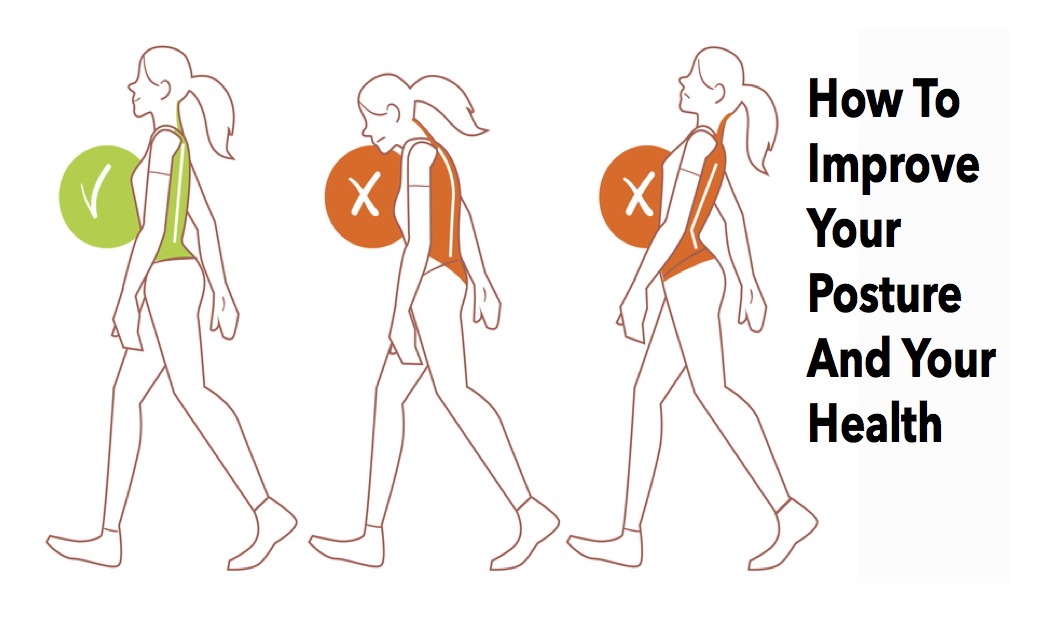Overcoming Pain from Poor Posture

Maintaining good posture is incredibly important for keeping the body pain-free and healthy.When posture is compromised, pain and other unintended consequences can ensue.
Fortunately, posture can be fixed and pain from poor posture alleviated by identifying the specific area where poor posture is exhibited and taking the necessary corrective measures. There are several ways to exhibit poor posture, and as a result, several ways you might develop pain from poor posture. The good news is that there are also many ways to improve your posture and health.
Ways You Might Be Demonstrating Poor Posture
A good rule of thumb for determining if your posture is in line is to check whether your earlobe, shoulder, hip, knee and middle of your ankle are all vertically aligned. If, upon examination, you find this is not the case, you might be suffering from any of the problems listed below.
- Hunch back – A person with hunchback will have a thoracic spine (upper back) that is curved at more than 40-45 degrees. This is often caused by leaning over a computer screen for too long, which causes the upper back muscles to weaken.
- Sway back – A person with sway back will have an anteriorly tilted pelvis, resulting in the appearance of a protruding belly and an arched lower back. This is also often caused by sitting at a desk or remaining sedentary throughout the day. It is the culmination of weakened abs, glutes and hamstrings.
- Head-forward – This common neck problem is where a person lets their head fall forward, rather than holding it squarely above the shoulders. This results in a loss of the lordosis, or curve in the cervical spine. It is often caused by looking forward and down too frequently, sleeping on a poorly-shaped pillow, and/or regularly carrying a heavy backpack.
- Over-pronated feet – When this occurs, the feet and ankles and knees will be caved inward. Many things cause this, including obesity, pregnancy and running.
How Poor Posture Might Be Hurting You
Poor posture can negatively affect your body and well-being on a daily basis. Some of these impacts, such as straining of the back and neck, are what we all commonly associate with poor posture. Other negative effects, such as digestive issues, are much less known. Some of the ways poor posture could be impacting you include:
- Straining of muscles and bones – When you slouch and defy your body’s naturally intended posture, your muscles and bones must work extra hard to keep your spine stabilized. After a while, the muscles and bones become tired. This results in painful straining. This straining is commonly associated with pain in the back and neck. It can also result in fatigue.
- Constrictions of the blood vessels and nerves – A habit of poor posture results in misalignment of the spine, which in turn constricts blood vessels and nerves around the spine. When blood vessels are constricted, they keep surrounding muscles from getting the blood, and, consequently, oxygen and nutrients they deserve. This also increases the chance of a blood clot forming. When nerves near the spine are constricted, they become pinched nerves and send pain signals to other parts of the body. This pain might sometimes become present in the form of a headache.
- Disruption of the digestive tract – Not only does sitting in a slouched position distort your back, it also cramps up your intestines. When you put this sort of pressure on the intestines, they become constricted and can leave you constipated and uncomfortable.
What You Can Do to Improve Your Posture and Alleviate Pain
There are many ways to bring your posture back to the way your body intends. Some of these include using devices that help correct your alignment. Others include exercises that turn good posture practices into habits. With some simple changes, you can get started on the path to better posture.
Start by making your workspace more ergonomically designed. Utilize the lumbar support in your office chair, and use a lower back pillow if necessary. Keep your eyes in line with the top third of your computer screen, and tilt the screen upward at a ten-degree angle. Additionally, don’t forget to get up and walk around every hour.
[Related: How Ergonomics Can Help Free You From Pain]
At home, consider your sleep setup. Firmer mattresses are the best for good posture. Avoid sleeping on your belly, and instead opting for your back or side.
The right kind of exercise, such as yoga, can improve your posture. Yoga strengthens muscles all over your body to promote good posture (this yoga.com article shows six helpful poses to start with). Plus, this ancient art offers more benefits than just improved posture.
Finally, for a very intentional way to make improved posture a part of each day, check out the Gokhale Method. This exercise method was developed by Esther Gokhale to incorporate posture-friendly habits into everyday life. For this reason, it is an excellent complement to sporadic exercises.
Maintaining proper posture is essential for living a healthy, pain-free lifestyle. While there are several ways to exhibit poor posture, there are also ways to fix it. At the end of the day, strengthen the muscles around the area of poor posture and choose to be conscious of your daily physical habits. This will help ensure you live a lifestyle free of pain from poor posture.
Have you overcome poor posture to improve your health and pain condition? Let us know in the comments below.
PainPathways Magazine
PainPathways is the first, only and ultimate pain magazine. First published in spring 2008, PainPathways is the culmination of the vision of Richard L. Rauck, MD, to provide a shared resource for people living with and caring for others in pain. This quarterly resource not only provides in-depth information on current treatments, therapies and research studies but also connects people who live with pain, both personally and professionally.
View All By PainPathways






